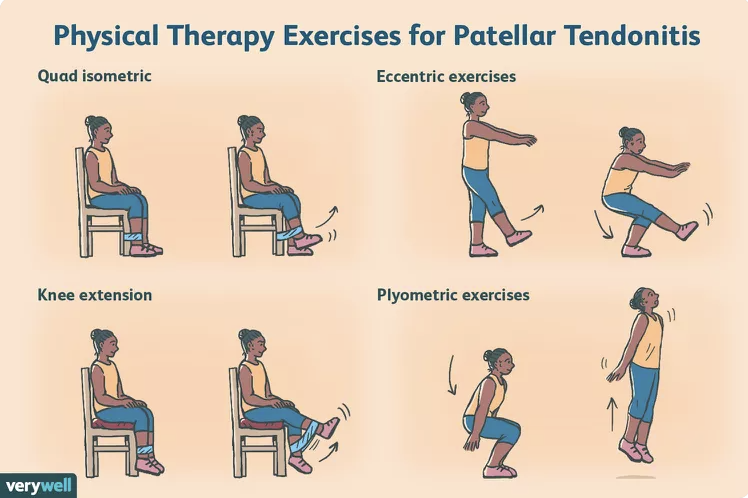Patellar Tendinitis
Patellar tendinitis, commonly known as jumper's knee, is a condition that affects the patellar tendon, the tissue connecting the kneecap (patella) to the shinbone (tibia). This injury is prevalent among athletes who engage in activities that involve repetitive jumping or explosive movements. In this article, we will delve into the various aspects of patellar tendinitis, including its causes, symptoms, diagnosis, prevention, and effective treatment options.
Causes of Patellar Tendinitis:
Patellar tendinitis is often a result of overuse and strain on the patellar tendon. Athletes involved in sports like basketball, volleyball, and soccer are particularly susceptible due to frequent jumping or running, which can lead to microtears in the tendon, triggering an inflammatory response.
Additionally, insufficient warm-up or poor conditioning of the muscles around the knee can contribute to increased stress on the patellar tendon during physical activity. Muscular imbalances, particularly weaknesses in the quadriceps or hamstrings, may also play a role, as they can affect the distribution of forces around the knee joint, placing greater strain on the patellar tendon. This overcompensation can result in more severe biomechanical factors, such as poor jumping or landing techniques, which can contribute to the development of patellar tendinitis. Improper body mechanics during sports activities can lead to abnormal stresses on the knee joint and exacerbate the risk of tendon injuries. Furthermore, individuals with anatomical factors like flat feet or high arches may experience altered biomechanics, increasing their susceptibility to patellar tendinitis. It is essential to address these contributing factors through proper training techniques, strengthening exercises, and biomechanical assessments to effectively prevent and manage patellar tendinitis.
Symptoms:
Recognizing the symptoms of patellar tendinitis is crucial for early intervention. Common symptoms include pain just below the kneecap, especially during activities that involve jumping or bending the knee. The pain may start as mild and gradually intensify if left untreated. Moreover, this pain will be extremely variable as an athlete might feel it severely at some times and not at all at other times.
Diagnosis:
Diagnosis typically involves a thorough examination by a medical professional. For example, a certified athletic trainer (ATC) would look for two plateaus below your knee (patella area) and discern whether the athlete feels pain in that area. From there the ATC could apply pressure on the patellar tendon area through multiple actions in order to figure out the nature of the strain. An important point to note is that usually if an athlete complains of knee pain, a medical professional must rule out other knee complications such as ACL tears, meniscus tears, etc. If the matter gets more complicated, athletes can see primary care professionals who will inquire about the athlete’s medical history, conduct a physical examination, and sometimes recommend imaging tests such as X-rays or MRI scans to rule out other potential issues.
Prevention and Treatment:
Prevention plays a key role in avoiding patellar tendinitis. Athletes and individuals engaged in high-impact activities can take proactive measures, including proper warm-up routines, gradual increases in training intensity, and incorporating strength and flexibility exercises for the lower limbs. Moreover, effective treatment for patellar tendinitis often involves a combination of rest, physical therapy, and lifestyle modifications. Here are some key components of treatment:
Rest and Activity Modification:
Giving the affected knee adequate time to rest is essential. This may involve reducing or avoiding activities that exacerbate the condition.
Physical Therapy:
A structured physical therapy program can help strengthen the muscles around the knee, improve flexibility, and address biomechanical issues contributing to the condition.
Electrical Stimulation
Electrical Stimulation, or E-Stim, is very effective in sending electrical impulses to the area where an athlete is feeling pain in order to relieve the area of stress caused by the injury.
Anti-Inflammatory Medications:
Nonsteroidal anti-inflammatory drugs (NSAIDs) may be recommended to alleviate pain and reduce inflammation.
Orthotics and Supportive Devices:
In some cases, orthotic devices or supportive braces may be prescribed to provide additional support to the knee.
Corticosteroid Injections:
In severe cases, corticosteroid injections may be administered to reduce inflammation and alleviate pain.
Surgery (in rare cases):
Surgical intervention is typically reserved for cases not responding to conservative treatments. This may involve removing damaged tissue or addressing underlying issues.
Recovery and Rehabilitation:
Recovery from patellar tendinitis is a gradual process. Following the prescribed treatment plan, engaging in rehabilitation exercises, and gradually returning to activity under the guidance of a healthcare professional are crucial steps in the recovery journey.
Conclusion:
Patellar tendinitis is a common overuse injury that can significantly impact an individual's ability to participate in sports and physical activities. Recognizing the symptoms early and seeking prompt treatment is essential for a successful recovery. By understanding the causes, symptoms, and effective treatment strategies, individuals can take proactive steps to prevent and manage patellar tendinitis, allowing them to return to their favorite activities with confidence and reduced risk of recurrence.
Sources:
“Patellar Tendinitis.” Mayo Clinic, Mayo Foundation for Medical Education and Research, www.mayoclinic.org/diseases-conditions/patellar-tendinitis/symptoms-causes/syc-20376113. Accessed 23 Jan. 2024.
“Patellofemoral Pain Syndrome.” OrthoInfo AAOS, orthoinfo.aaos.org/en/diseases--conditions/patellofemoral-pain-syndrome/. Accessed 23 Jan. 2024.
Santana, Javier A, et al. “Jumpers Knee.” National Library of Medicine, 22 Apr. 2023, www.ncbi.nlm.nih.gov/books/NBK532969/.


